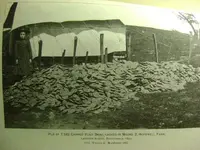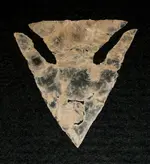You are using an out of date browser. It may not display this or other websites correctly.
You should upgrade or use an alternative browser.
You should upgrade or use an alternative browser.
Check out this mountain of cache blades!
- Thread starter Th3rty7
- Start date
P
pickaway
Guest
Thanks John yea I know who Jarrod is. Yea he found one up on the old peters farm, he was working the snake den mounds which are down the rd. from me, he's having a PARG meeting 2-12 be interesting to see what he's come across.Hopewell said:No problem at all; glad to share them.
Pickaway - I have a copy of the earliest map done of the Circleville Works from the 1780s. They were first described by Reverend David Jones when he was traveling among the Shawnee in 1771. I know of a copper celt that was found within the earthworks before they were totally destroyed. Dr. Jarrod Burks has done a lot of remote sensing at sites and actually discovered some previously unknown earthworks North of Circleville.
Sincerely,
John
Jeff...Hopewell was not a culture...it was actually an ideology that took over the indigenous groups of Illinois and Ohio during the Woodland period. You see ceremonialism and exchange of exotic goods beginning in Glacial Kame, expanded upon in Early Woodland (Adena), reaching a climax in Middle Woodland, and a total decline in Late Woodland. Some areas during the Middle Woodland period were surrounded by "Hopewell" but did not participate...that is why I say it was an ideology.
To be honest, I hate using the terms Adena and Hopewell, but unfortunately, Moorehead and Mills put them into our permanent vernacular. The Hopewell ideology is centered around ceremonialism, shamanic elements and a cult of the dead. For reasons that I will be presenting in an upcoming paper, I believe this ideology is Asiatic in origin. Not everything in Middle Woodland is Hopewell.
Sincerely,
John
To be honest, I hate using the terms Adena and Hopewell, but unfortunately, Moorehead and Mills put them into our permanent vernacular. The Hopewell ideology is centered around ceremonialism, shamanic elements and a cult of the dead. For reasons that I will be presenting in an upcoming paper, I believe this ideology is Asiatic in origin. Not everything in Middle Woodland is Hopewell.
Sincerely,
John
Th3rty7
Silver Member
- #43
Thread Owner
Jeff Stafford said:Sincerely guys........................Is it any wonder I think the Hopewell stuff in the Ozarks should be turned down a little-and not every thing called Hopewell,be a bit of push.............to think we HAVE ANY of that kind artifacts from Hopewell like those in the Ozarks...................
So I have one or two Synders ..........
Hopewell was a Culture not points................


Jeff, there's alot of knowledgeable people around here that you could learn alot from. There's also alot of people trying to learn and some of the misinformation in your posts isn't helpful.
K
Keokukjeff
Guest
P
pickaway
Guest
Let me know where i can read your upcoming paper,I did see some of your artifacts from some of the Hopewell mounds in Ross county in the ASO mag. amazing artifacts...Hopewell said:Jeff...Hopewell was not a culture...it was actually an ideology that took over the indigenous groups of Illinois and Ohio during the Woodland period. You see ceremonialism and exchange of exotic goods beginning in Glacial Kame, expanded upon in Early Woodland (Adena), reaching a climax in Middle Woodland, and a total decline in Late Woodland. Some areas during the Middle Woodland period were surrounded by "Hopewell" but did not participate...that is why I say it was an ideology.
To be honest, I hate using the terms Adena and Hopewell, but unfortunately, Moorehead and Mills put them into our permanent vernacular. The Hopewell ideology is centered around ceremonialism, shamanic elements and a cult of the dead. For reasons that I will be presenting in an upcoming paper, I believe this ideology is Asiatic in origin. Not everything in Middle Woodland is Hopewell.
Sincerely,
John
Part of it will be in the talk I am giving at the Garst Museum next weekend; for the May ASO symposium, I am working on a presentation of the engraved bone and shell objects during the Middle Woodland period.
Thank you for the compliment on the articles; I was not crazy about the picture with the colored pieces and the captions were all messed up.
~John
Thank you for the compliment on the articles; I was not crazy about the picture with the colored pieces and the captions were all messed up.
~John
P
pickaway
Guest
Hopewell said:Part of it will be in the talk I am giving at the Garst Museum next weekend; for the May ASO symposium, I am working on a presentation of the engraved bone and shell objects during the Middle Woodland period.
Thank you for the compliment on the articles; I was not crazy about the picture with the colored pieces and the captions were all messed up.
~John
lol yea i was trying to match the pieces up on pg. 21 i was like wtf! I probably spent 30 minutes on that page... but other than that ,it was very nice. Where is the Garst museum located at?Times etc...That one carved bone whistle is amazing, do you own that piece?
P
pickaway
Guest
Ok googled it, found it ,just might go looks like an interesting event.Tony the man... 

That's cool; make sure you come over and chat. I will have a display of material from the Hopewell Site, Manring Site and Whitacre site there. This mica pieces was found at the Whitacre Site, and I will have it on display.
The Ohio Historical Society owns the bone whistle; the former curator, Ray Baby, exchanged a quarter of classes at OSU to the State Patrolman that had it for the piece. I would like to make a cast of it, and several other carved pieces, but I may have to do it all freehand.
See you at Garst!
~John
The Ohio Historical Society owns the bone whistle; the former curator, Ray Baby, exchanged a quarter of classes at OSU to the State Patrolman that had it for the piece. I would like to make a cast of it, and several other carved pieces, but I may have to do it all freehand.
See you at Garst!
~John
Attachments
naturegirl
Bronze Member
What a fragile beauty that is! Can you explain what you mean by "freehand"?
naturegirl
naturegirl
The mica point effigy is paper thin; I am amazed it survived as well as it did since it was found in a midden level. There was definitely cut mica production at the site as several cut objects were found during the excavations.
by freehand, I meant that I would have to carve it by hand since OHS will not allow casting of their artifacts. I am looking to secure elk fibula bone as it would be the closest in size to human femurs. My plan was to have a set of the various engraved bone and shell pieces on display for the May ASO Symposium, but I doubt I could complete them in time.
Sincerely,
John
by freehand, I meant that I would have to carve it by hand since OHS will not allow casting of their artifacts. I am looking to secure elk fibula bone as it would be the closest in size to human femurs. My plan was to have a set of the various engraved bone and shell pieces on display for the May ASO Symposium, but I doubt I could complete them in time.
Sincerely,
John
P
pickaway
Guest
Thats an amazing artifact, thanks for showing it...
1320
Silver Member
- Joined
- Dec 10, 2004
- Messages
- 3,436
- Reaction score
- 2,311
- Golden Thread
- 0
- Location
- East Central Kentucky
I couldn't resist bumping this great post by 37 in regard to the cache...good stuff here!
trevmma
Bronze Member
- Joined
- May 23, 2006
- Messages
- 1,117
- Reaction score
- 664
- Golden Thread
- 0
- Detector(s) used
- whites 1000
- Primary Interest:
- All Treasure Hunting
any one ever heard of the powell cache found in warren county ohio made up of huge chunks of obsideon, obsideon points and also crystal clear points, and beautiful knifes made out of green red yellow u name it flintridge and of course hornstone disk
Similar threads
- Replies
- 4
- Views
- 697
- Replies
- 10
- Views
- 810
- Suggestion
- Replies
- 34
- Views
- 6K
Users who are viewing this thread
Total: 1 (members: 0, guests: 1)










